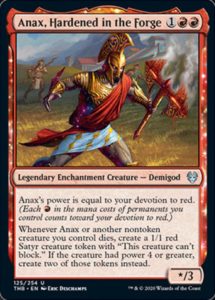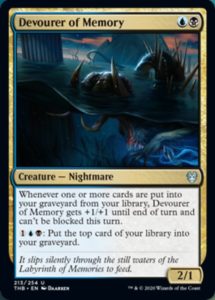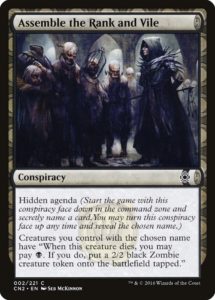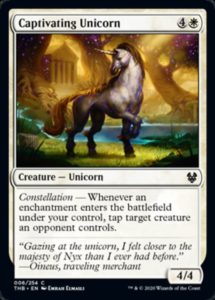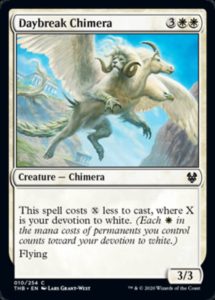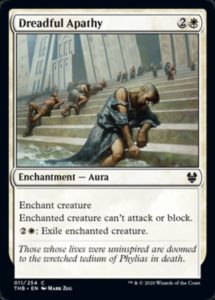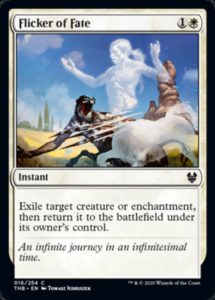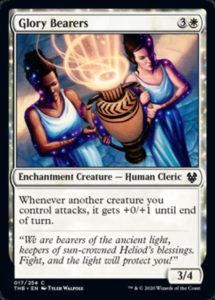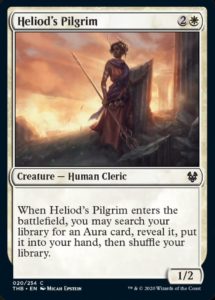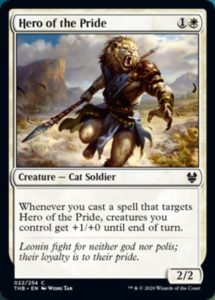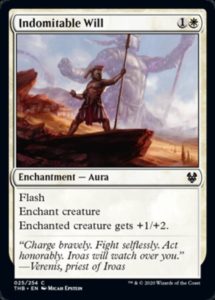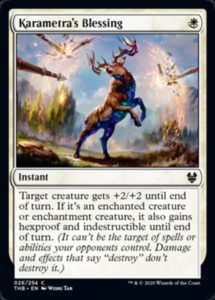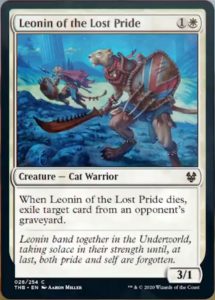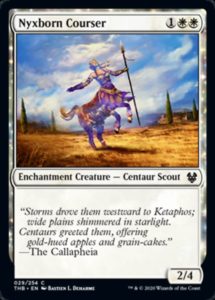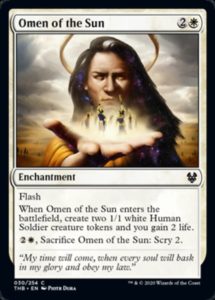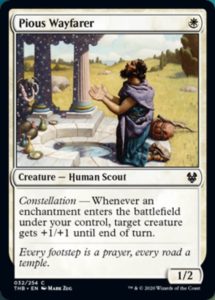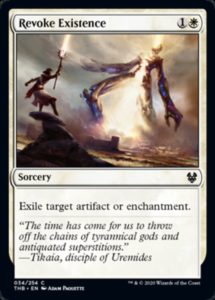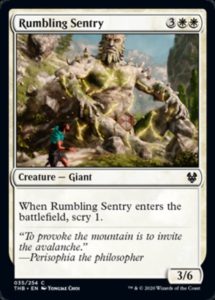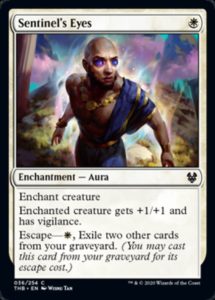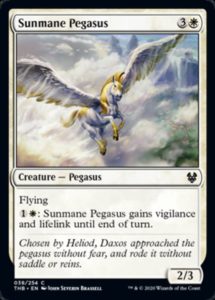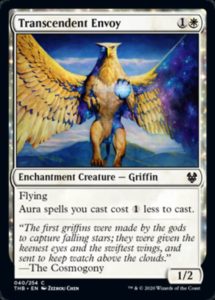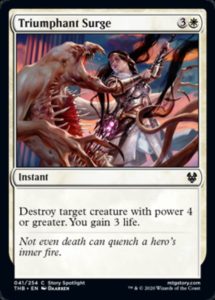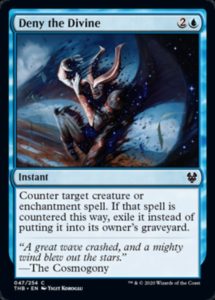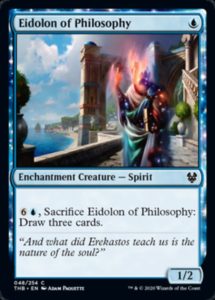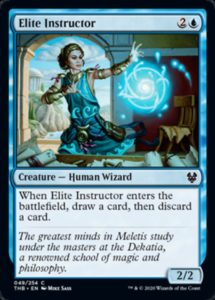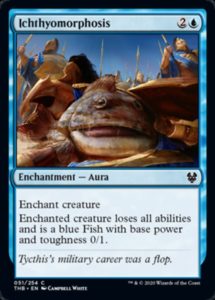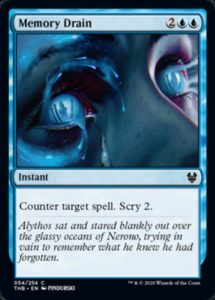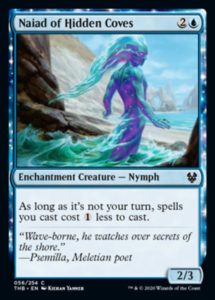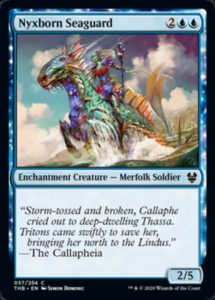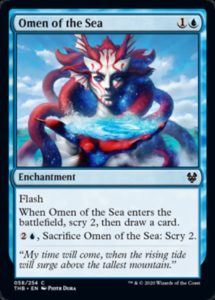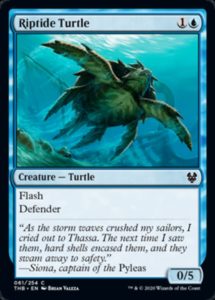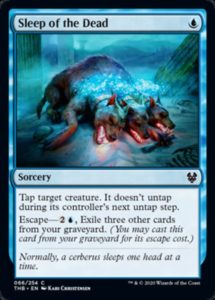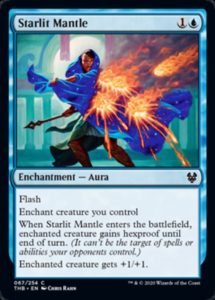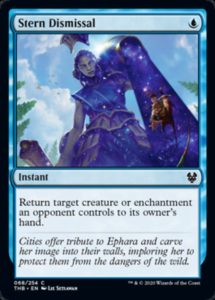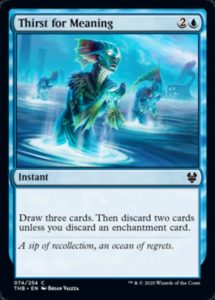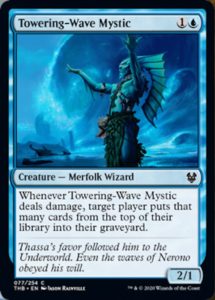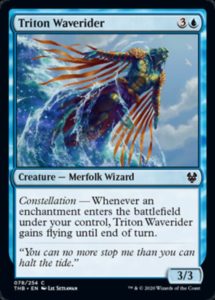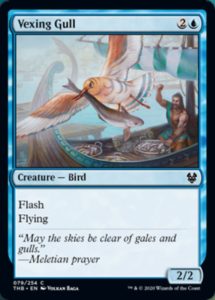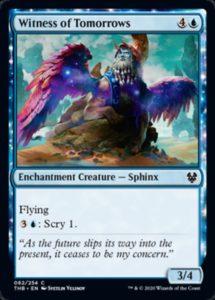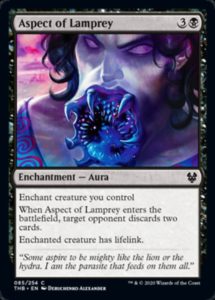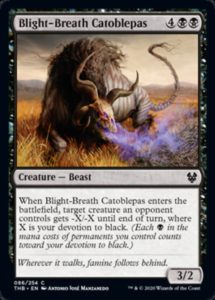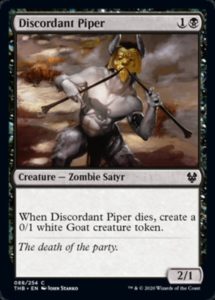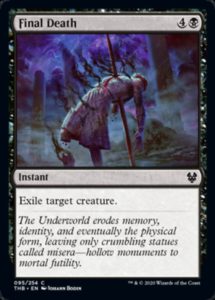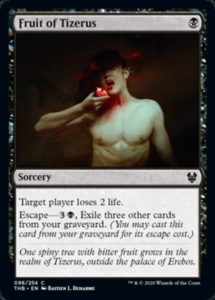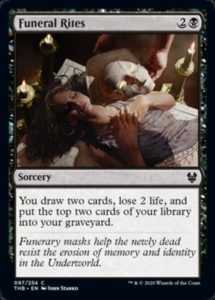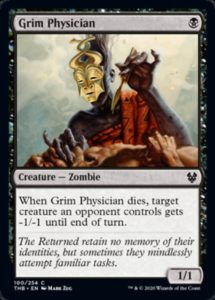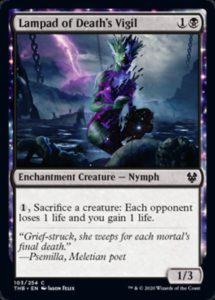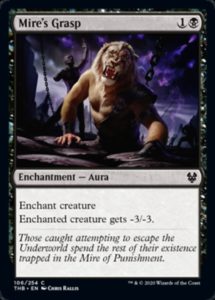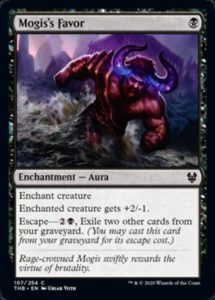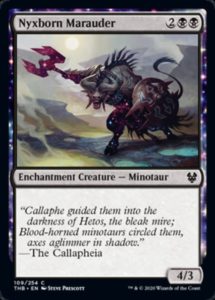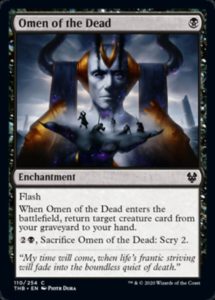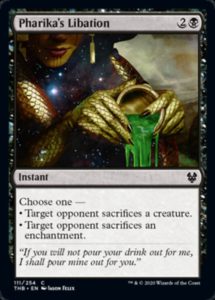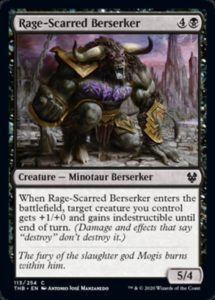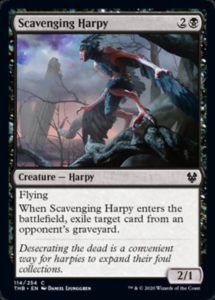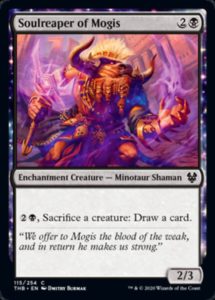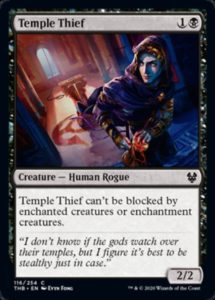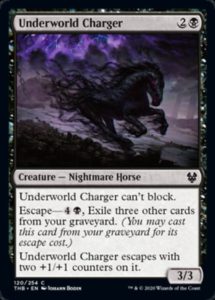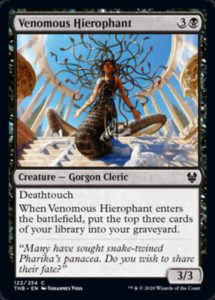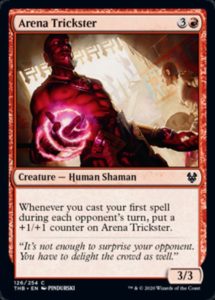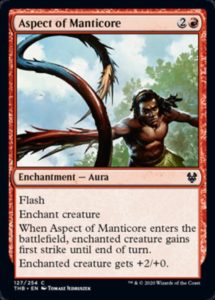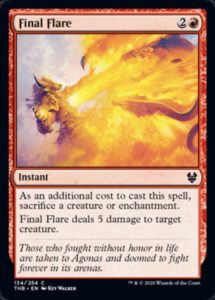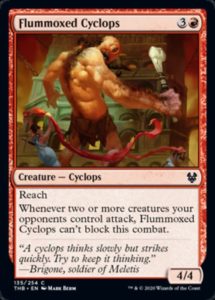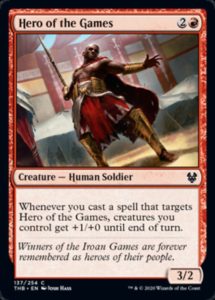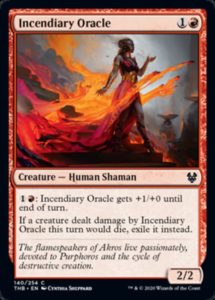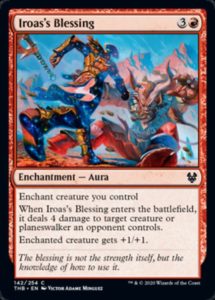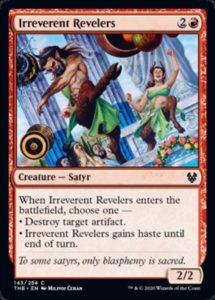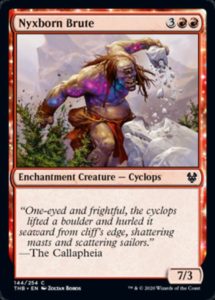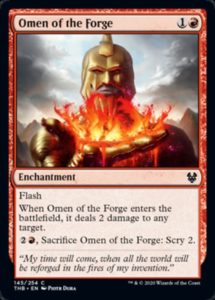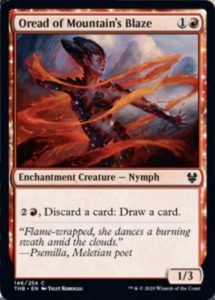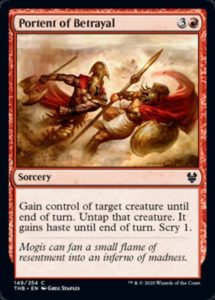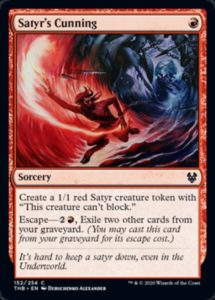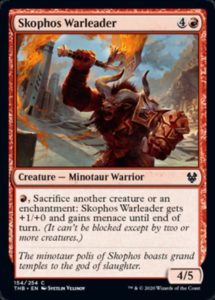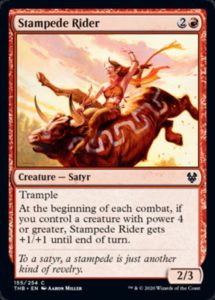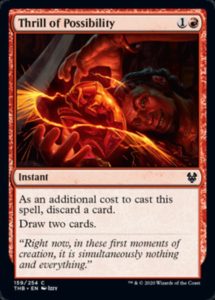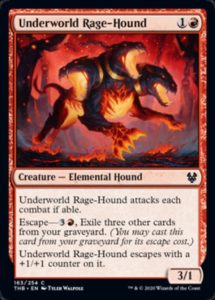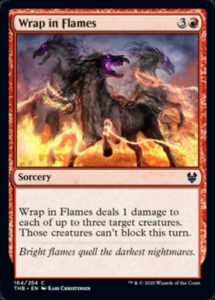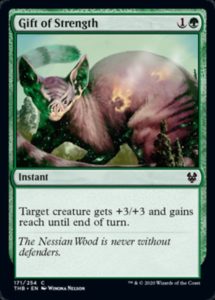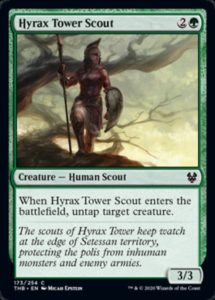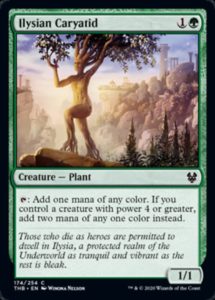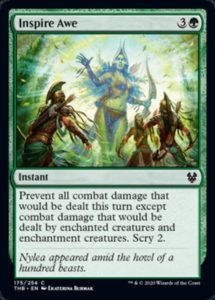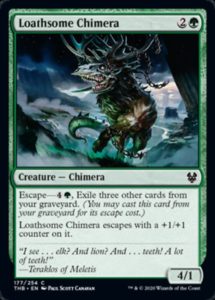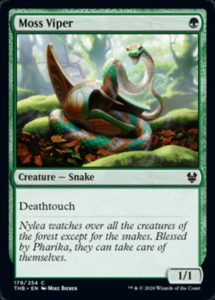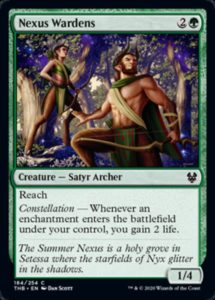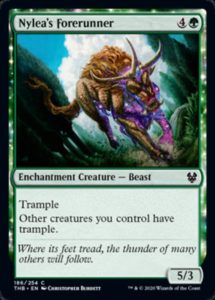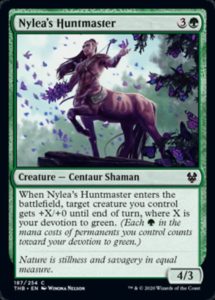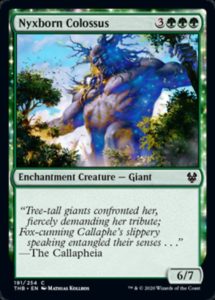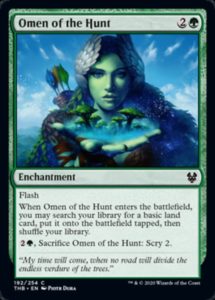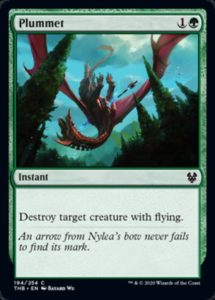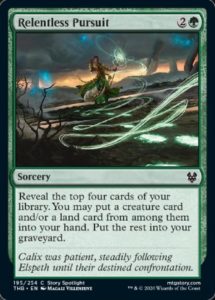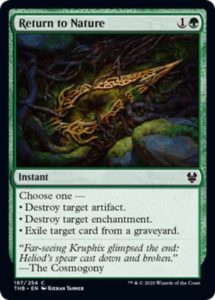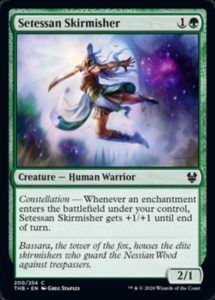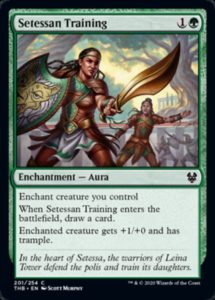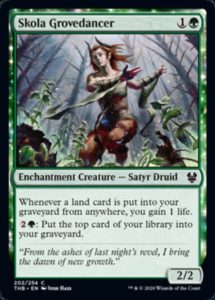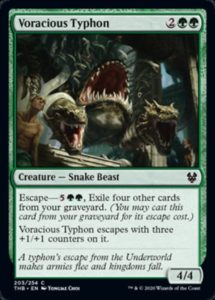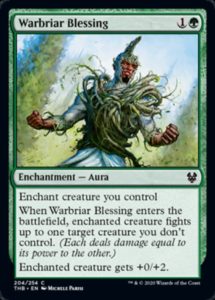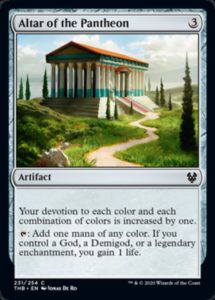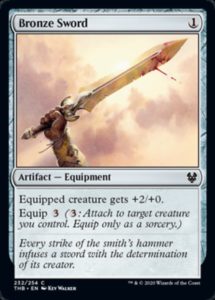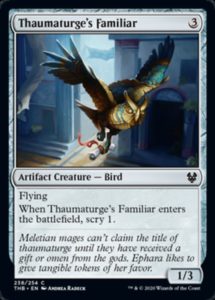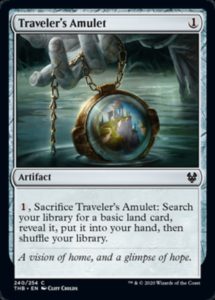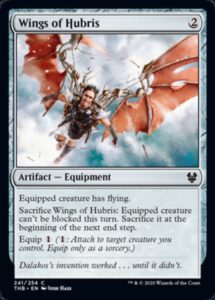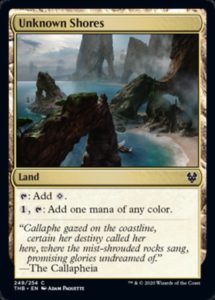Theros Beyond Death prerelease is this weekend. After that, there’s Grand Prix New Jersey, and after that a trio of Regional Players Tours. These all provide ample reason to learn the Limited format, and commons are the lifeblood of Limited. Today, we’re going to quickly analyze every single common in the set. But before we jump in, let’s take a quick macro-level view of Theros Beyond Death.
Mechanics
Set mechanics are the foundation of themes and archetypes. How do the mechanics in Theros Beyond Death look and what do they say about the format?
Escape is the only new named mechanic in Theros Beyond Death, and it’s a doozy. We’ve written an entire article about it. Escape shows up in all five colors, but only black, red, and green receive common Escape creatures. It’s the only mana sink mechanic and (usually) provides card advantage, so there’s a lot riding on how good it is and how easy it is to enable. If Escape is too strong, games can devolve into grindy, repetitive slugfests as the same creatures smash into each other. If it’s too weak or hard to enable, it will do little, perhaps being relevant only once or twice in the average game.
Constellation returns from its brief appearance in Journey into Nyx. The big question for its relevance is how powerful the payoffs are and how easy it will be to get quality enchantments. Constellation appears only in white, blue, and green.
Devotion returns after its smash success the first time on Theros and presents an interesting deckbuilding puzzle. It does the cool thing of making permanents with color-demanding mana costs stronger rather than weaker. This changes evaluations of commons, especially in white, black, and green—the three colors that get a common devotion payoff.
Sagas are back from Dominaria. They’re nowhere near as major a set theme in the absence of Historic, but they’re enchantments that eventually leave play. Sagas are balanced across all colors.
Flash-matters. That’s what I’ll call the first-card-on-opponent’s-turn matters mechanic, since FCOOT looks ridiculous. This is the UR mechanic and a very minor one—there are six cards that reward this theme in the entire set and only two are common. I suspect these rewards this won’t be worth the effort most of the time, as was the case with ELD’s UR mechanic, but the addition of a bunch of flash cards is not something to be trifled with. It’s also worth noting that this is another A+B mechanic (one combining different cards with different properties) in the set, alongside Constellation and our final two mechanics.
Heroic makes a cameo appearance on five red and white cards. It works the same way as it always did (rewarding you for targeting this creature with a spell), but the payoff is now always the same: creatures you control get +1/+0.
Ferocious also returns in red and green, rewarding you for having creatures with power 4 or greater. This is a pretty swift return for an unnamed mini-theme, since this was also in Ravnica Allegiance.
Themes
Every color pair pushes towards certain themes and interactions. Sometimes, these are very explicit (Guilds of Ravnica), other times, they quite loose (Throne of Eldraine). So, what are the colors about?
WU—Enchantment Tempo. Staggering Insight doesn’t give clear insight into what WU is about, but both colors have a mixture of flying, Constellation, auras, and disruption. There are a lot of ways this color pair could play out, but no obvious approach.
UB—Self-mill. Use your graveyard for value.
BR—Sacrifice. Use Portent of Betrayal or sacrifice fodder, then profit.
RG—Ferocious. Big creatures are good.
GW—Auras/Constellation. Siona, Captain of the Pyleas has a lot of text, but she rewards you for white and green’s buffing auras, especially Warbriar Blessing.
WB—Mean auras/Attrition/Devotion. Rise to Glory‘s job is to get back a Mire’s Grasp or Dreadful Apathy. This color pair probably more than any other rewards you for going deep on one of the two colors, since both have potent common Devotion rewards.
UR—Flash-matters/First-spell-on-opponent’s-turn-matters. Rolls off the tongue.
BG—Graveyard. This color pair has more common Escape rewards and enablers than any other.
RW—Heroic Go-Wide. While there are only two “Heroic” commons, this color pair rewards a single, explosive wide attack.
GU—Constellation. Play enchantments, get rewarded.
And with all that out of the way, we’re finally ready to start reviewing!
The Ranking
For this review, I’m bringing back the letter grading last seen in our War of the Spark common review. Please note that this scale is only applicable to commons; any uncommon, rare, or mythic better than the best common explodes off the scale, damaging our delicate sensor equipment. This review comes out before the set is playable in any form, so it’s conjecture based on past experiences. Ultimately, it’s meant as a guide to those who need one and framework for discussion to those who don’t.
A: One of the best commons in the set. These are first-pickable.
B: A high quality common, it should almost always make your deck (if it’s in your colors) and sends a strong signal that this color is open. This can also include powerful, archetype-specific cards that don’t go into every deck of this color.
C: A fine common. These includes most creatures with decent stats, serviceable removal spells, and some of the better combat tricks. This is the most common grade for a common.
D: A fine, but lower tier common. This category tends to include most combat tricks and most serviceable creatures (combat tricks always compete for space with creatures and removal, so I rate them lower), as well as cards that can be strong out of the sideboard.
F: You’d really prefer these cards not to go into your main deck. This includes very low power cards and cards that in very specific archetypes might have a role to play. Please note that not all Fs are unplayable, just weak.
Captivating Unicorn is the second ever common monowhite creature with four power, though a 4/4 for five is nothing to get excited. It might not be easy to get two triggers once you’ve started topdecking, but this can yield explosive, game-winning combat turns (especially as a curve-topper in GW or RW).
A 3/3 flying for five doesn’t cut it anymore (white gets 3/4s for 5 regularly and blue gets them with upside), but Daybreak Chimera looks awesome. This requires Daxos, Blessed by the Sun or Pious Wayfarer to come down on turn three, but deploying this for two mana on turn four or turn five alongside another spell is pretty awesome.
Grade: B
Choking Restraints is back and better than ever as Dreadful Apathy. Sure, three mana Pacifisms don’t really cut it these days, but this can shut down Escape creatures and enable enchantment bonuses.
Grade: A
Flicker of Fate, like similar effects, answers to combat tricks and removal, and can retrigger enters-the-battlefield effects. Unfortunately, they are neither threats nor answers, making them generally worse in Limited.
Grade: D
None of the individual pieces are great, but collectively Glory Bearers looks like a fine creature. Four mana for a 3/4 is okay but not great. The ability isn’t exciting either, but a free +0/+1 can really throw off combat math. Plus, this is an enchantment creature for Constellation.
Grade: C
Back from M15, Heliod’s Pilgrim has 23 options to search for. Much of the time, it’ll get Dreadful Apathy, Mire’s Grasp, or Warbriar Blessing. The stats are awful, but a tutor is a pretty solid reward.
Grade: C
Hero of the Pride offers pretty minor upside for a 2/2 for two, stats that haven’t been great in Limited for a while. This will be a critical piece of fast RW decks, but most other decks might have little use for it.
Grade: D
Back from Kamigawa, Indomitable Will is going to be that awkward combat trick that is awful most of the time and incredible when your opponent plays it against you. Flash on an enchantment is relevant, since it can trigger Constellation or Flash-matters when your opponent least expects it, but you can do a lot better.
Grade: F
The return of the W: +2/+2 with upside combat trick is back! Karametra’s Blessing probably best in RW Heroic, but likely good enough to see play in WU and GW decks that can go tall.
Grade: D
Normally, a 3/1 for two is pretty awkward, since it gets in a hit and then gets invalidated by a four-toughness creature or trades. However, there’s added utility to filling your graveyard thanks to Escape, and Leonin of the Lost Pride is excellent at trading with Escape creatures.
Grade: C
In an average format, 1WW for a 2/4 is a somewhat aggressively costed blocker and otherwise unremarkable. However, Nyxborn Courser is a devotion and Constellation enabler that defends the ground. It’s not great on its own, but WU, GW, and heavy white decks should have extra use for it.
Grade: D
Nothing about Omen of the Sun looks particularly strong. This is at its best in RW Heroic, alongside black’s sacrifice cards, or for trading for a 2/2. I think that plus the scry gives enough added utility to bump this out of D range, but am ready to be wrong.
Grade: C
Yuck. If Pious Wayfarer reliably triggered every turn, it’d be an amazing one drop, but you need to invest mana and cards repeatedly for it to work. This could be a key component of hyperaggressive decks and heavy white Constellation/Devotion decks, but most decks have no use for a 1/2 with minor upside.
Grade: F
There are plenty of targets for Revoke Existence, even if it can’t hit any Escape creatures. It should be a solid removal spell, especially in Sealed where everyone will be playing Entrancing Lyre.
Grade: B
Rumbling Sentry is similar to Glory Bearers in that it does nothing particularly well, but it has several minor utilities. It blocks exceedingly well, makes your topdecks better in the mid-to-late game, and provides two pips of Devotion. That’s probably not enough to justify the four mana cost, and it looks far worse than white’s other five drops Captivating Unicorn and Daybreak Chimera.
Grade: D
In a normal format, Sentinel’s Eyes would probably be an F. However, this enables Constellation and Heroic, works well alongside self-mill, and its Escape cost is so cheap that you can reasonably recur it and trade up in combat multiple times a game. There’s every chance that this card is awful, but I expect it slots in enough decks and will do enough work that it could be a key component of many white decks.
Grade: C
Alabaster Kirin is a decent card, especially when Morph meant the format was full of 2/2s. Sunmane Pegasus is better in a board stall or race because of Lifelink, but two mana is a hefty price to pay. White only has two common four drops, and this might be better than Glory Bearers; but I’d start the format prioritizing the enchantment creature with decent stats over the flying creature with mediocre stats.
Grade: D
There are 23 auras in Theros Beyond Death, but only 19 of them benefit from Transcendent Envoy‘s cost reduction. While flying and being an enchantment creature are also reasonable bonuses, the combined package leaves much to be desired. Perhaps there’s enough support for aggro that a 1/2 evasive creature slots in well within Heroic, Constellation, Devotion, and aura-focused decks; but it feels very much like a replacement-level common. I’m ready to eat my words here, but a lot needs to go right for this griffin to be a valuable creature in and of itself. [Ed. note: Expect this card to transcend its low rating.]
Grade: D
Triumphant Surge swings from a sideboard card to a reasonable playable. The lack of Bestow and Monstrosity suggests that creatures will be smaller in THB than they were in Theros. Nevertheless, red and green have a large than usual number of 4+ power common creatures to support their theme (and even white has a common target for this), so it’s not the most dangerous card to maindeck.
Grade: D
Blue

A seven-mana 5/6 isn’t worth discussing, but even green doesn’t get five-mana 5/6s. Brine Giant combines well with Constellation and Omen of the Sea and could be a great curve topper. It’s still an expensive card that requires setup, but it can invalidate almost any opposing ground creature.
Grade: C
You’ll play Chain to Memory when you have to, but most of the time you should be appreciating this art in your sideboard. It’ll feel great when you get someone with this, but it lacks the utility of a combat trick or the certainty of a removal spell.
Grade: F
No Escape is back without the scry as Deny the Divine. Exiling is even more relevant in Theros, since this shuts off Escape creatures and denies opponent’s Escape fodder. Three mana conditional counterspell tend to be serviceable but lackluster playables, and UR focusing on Flash suggests that there are plenty of creatures you could deploy if you opt not to use Deny the Divine; but there are only two common Flash creatures.
Grade: D
Once upon a time, I was a philosopher. I love Traveling Philosopher and I love Eidolon of Philosophy (the cousin of Shore Keeper). That said, you need a ton of Constellation payoffs or a strong hyperaggro plan to make this work, since seven mana is an eternity.
Grade: F
Looting is always good, and it’s even better when it bins an Escape card (effectively drawing you a card) or provides Escape fodder. If a 2/2 is a reasonable body, Elite Instructor could be one of blue’s best common creatures. If it’s not, you’re paying a lot for a single loot. Given that blue only has one Escape common and it’s not a creature, I suspect this will be better in GU and UB decks and not as stellar in all blue decks.
Grade: C
Ichthyomorphosis is the latest aura-based Polymorph effects, which are generally bad even when they cost two mana. You’ll play one of these if you’re short on removal, and it’s better in a set with Constellation and Heliod’s Pilgrim, but it’s still a bad removal spell.
Grade: D
Four mana is a ton to hold up and Memory Drain is no Dismiss. This isn’t even a great answer to gods, since it costs as much or more than all but one of them. If you really need countermagic, you can board this in, but it’ll always cost more than you like and it won’t support the UR proactive Flash-matters archetype.
Grade: F
Here’s a super swingy card. Naiad of Hidden Coves is obviously a part of the UR Flash-matters archetype, but being an enchantment and fine blocker are real pluses; and it alone turns mediocre cards into undercosted and much more powerful cards.
Grade: B
Each color has a vanilla common enchantment creature with two pips of devotion. This cycle is beautifully designed; and while Nyxborn Seaguard isn’t stellar, it slots into control, skies, Constellation, and Devotion decks. The added invisible utility could be enough to make it a common you’re not unhappy to play, whereas normally Wishcoin Crab is a pretty anemic playable.
Grade: C
For one extra mana, you get a Preordain that works with Constellation, Flash-matters, Devotion, and sacrifice themes, which can bin itself for added value and to fuel Escape. Cantrips are worse in Limited than they are in Constructed, since Limited is more defined by quantity of threats than quality, but this card offers a ton of power.
Grade: B
Riptide Turtle looks a whole lot like a removal spell, but Flash isn’t a huge upgrade to Murmuring Phantasm. It doesn’t even help the Flash-matters archetype much, since it applies no pressure by itself. Perhaps this is an excellent blocker with five toughness, but it does little to dissuade or punish your opponent from attacking.
Grade: F
If Sleep of the Dead were an instant, it’d be the perfect tempo spell for Flash-matters and a lot more powerful. Instead, it’s a more grindy tempo removal spell. Control decks can use this to buy a lot of time against a single creature (since blue has no common hard removal) and aggro decks could set up big turns where they lock down two blockers out of nowhere. In the right deck, this could swing the game around, but in most decks, it’s card disadvantage.
Grade: D
For one extra mana, your Ranger’s Guile provides a permanent buff? Sign me up! Starlit Mantle is the kind of tricky blue spell that tempo decks will love, since it can throw off combat math, protect a creature from removal, and enable Constellation and Flash-matters at instant speed. Blue doesn’t often get combat tricks that buff power, and I’m pretty excited to see what a tempo-focused blue can do with this.
Grade: C
Unsummon is best in tempo decks, and Stern Dismissal trades being able to save your own creatures from removal for being able to bounce noncreature enchantments. It’s also a cheap, relevant, self-binning spell, making it a solid enabler for Escape decks looking to outmaneuver their opponents and mess up their opponent’s Escaped creatures.
Grade: B
Blue might have mostly anemic common creatures and no hard removal, but holy crap does it have card advantage. Thirst for Meaning can filter your hand when you’ve got lands to spare or gas you up at instant speed if you’ve built your deck properly. It even helps you bin Escape creatures that power up when they Escape. There’s a pretty strong argument for this as blue’s best common.
Grade: A
A 2/1 for two is a weak set of stats, but Towering-Wave Mystic‘s ability is very powerful for a UB deck. You should basically always point this at yourself, since it enables Escape perfectly (if the game has gone super long, this is probably unable to connect, but you could mill your opponent out if he’s wearing Wings of Hubris).
Grade: D
Triton Waverider resembles Weldfast Wingsmith, which was a weak card. Sure, it existed alongside hyperaggressive, unblockable creatures like Renegade Freighter and Thriving Rhino, but most decks have little use for a Hill Giant that sometimes Jumps.
Grade: D
We’ve written an entire article on Vexing Gull. Wind Drake hasn’t been a particularly good card in the better part of a decade, and Flash isn’t a huge upgrade on a creature only able to eat 1/1 fish.
Grade: C
Blue gets 3/4 flyings for five with upside, and Witness of Tomorrows is a pretty awesome curve topper. It lacks the immediate advantage of Cloudreader Sphinx protection of Boreal Elemental, but it has a relevant second type and provides a mana sink for the late game while being splashable.
Grade: A
Black
Mind Rot tends to be a fine card, even when it costs a bit extra, and leaving behind Lifelink is gravy. Aspect of Lamprey lacks the focused power and fragility of Mark of the Vampire and can be disastrous against Escape decks, but much of the time, you’ll probably get your mana’s worth out of this incredibly gross-looking card. It’s nothing super exciting, but worth playing around when you’ve got the opportunity.
Grade: D
I read Blight-Breath Catoblepas over and over and keep expecting it to be an uncommon. Sure, those are some lousy stats on a Flametongue Kavu, but Flametongue Kavu isn’t a common. You can get too many of these and be stuck with too many six drops, but even in a not-so-dedicated black deck, this casts Disfigure when it enters the battlefield (unless your opponent has an instant speed removal spell). It’s not often that a six mana creature is in the running for top 5 commons, but we never get FTKs at common.
Grade: A
Outside of a dedicated sacrifice deck, Discordant Piper is a bad creature that leaves behind a terrible creature. That’s fine if you really, really need to block, but there are better creatures than this.
Grade: D
Final Reward was awful in hyperaggressive Amonkhet (where it shutting down Embalm creatures didn’t matter, since almost no one had time to use them). Theros looks to be slower and reward exiling removal, but five mana is still a lot to ask, especially when black already has Blight-Breath Catoblepas and Mire’s Grasp. You’ll play Final Death, but this is probably black’s third-best common removal spell and the one other colors are most likely to splash for. I’m ready to be wrong here, but with the increased power of two and three drop creatures, five mana removal is worse than it used to be.
Grade: B
In most decks, Fruit of Tizerus is unplayable. In a very focused aggro deck that’s trying to squeeze out the last few points of damage, it’s theoretically playable.
Grade: F
Funeral Rites turns on Escape 3 by itself and provides card advantage? Sign me up!
Grade: B
Grim Physician hits 10/55 common creatures and trades with 11 two-toughness creatures in combat. That’s solid utility for a one drop and even more so when it plays into BR’s sacrifice theme.
Grade: C
Lampad of Death’s Vigil is an easier to use Gnawing Zombie with enchantment and sacrifice synergies that also blocks quite well. This could secretly be one of black’s best common creatures and can suddenly kill an opponent who lets their life fall too low.
Dead Weight is awesome. Mire’s Grasp is “deader weight” and also awesome. It kills most common creatures, plays into the WB “auras on a dead creature” subtheme, and is aggressively costed. Even when it can’t outright kill a creature, it neuters almost everything else. This might be better than Blight-Breath Catoblepas just because you essentially can’t overload on cheap, efficient removal.
Grade: A
I’m less excited about Mogis’s Favor than Sentinel’s Eyes. Sure, it’s a sorcery-speed Darkblast against one toughness creatures, but it’s rarely going to upgrade one of your threats in a meaningful way. This could be a great sideboard card or a key piece of Heroic/Constellation aggro, but most of the time it probably shouldn’t be in your main deck.
Grade: D
Nyxborn Marauder has aggressive stats and provide Devotion in a color that really, really rewards Devotion. Works for me!
Grade: C
Omen of the Dead offers a ton of utility here for one mana. An instant speed Raise Dead is a playable card, and the added Flash-matters, Constellation, and Devotion bonuses bring it almost into the B range, which is unusual for a noncreature, non-removal spell.
Grade: C
Black is chock full of removal in THB, but Pharika’s Libation doesn’t seem great. Edict effects are at their worst in Limited, since basically every deck plays a large array of creatures. Sometimes you can switch to enchantment mode to pick off an enchantment creature in a board full of tokens, but three mana is a lot to ask for so little control.
Grade: D
Normally, green’s the color that gets a 4/3 for four and a five-power five drop with upside, but black is ready to brawl. Rage-Scarred Berserker is a potent threat by itself and make a stymied creature relevant out of nowhere. It’s still an expensive threat, but black does very well when it has solid threats alongside excellent removal.
Grade: C
I rag on Wind Drake a lot, but black is often better able to leverage fragile fliers with its powerful removal. The minor upside is solid at fighting Escape, and Scavenging Harpy could be enough win condition for removal-rich black.
Grade: B
Spark Reaper‘s back, too?! As with Deny the Divine, it’s lost some utility, but that makes sense when considering how bonkers powerful War of the Spark was. Soulreaper of Mogis is a great way to take advantage of a board stall or buy time while your Catoblepas comes online.
Grade: C
Not gonna lie, Temple Thief feels like a blue card. It’s a weak threat and plays poorly with most of black’s archetypes, but it’s a two drop in a pinch. Unless black aggro is really good or you really, really need two drops, this is probably only slightly better than Duskmantle Operative.
Grade: F
Marauading Boneslasher is back and looking a whole lot more like Stallion of Ashmouth. Underworld Charger is awesome at everything except blocking and a great finisher.
Grade: B
A fine attacker, a reasonable blocker, and a relevant enters-the-battlefield ability all combine to make Venomous Hierophant more than the sum of its parts.
Grade: C
Red
Arena Trickster is the only common payoff for Flash-matters (Naiad of Hidden Coves empowers flash creatures, but doesn’t profit from them). If you contort your curve and work really, really hard, you get a four mana 5/5 on your opponent’s sixth turn. Unless the format is supremely grindy, that’s not good enough. Brineborn Cutthroat is a great card because it’s cheap, triggers multiple times a turn, and is just good enough when not beefed up. This is none of those things and suggests that Flash-matters won’t work if you only have common payoffs.
Grade: D
Dragon Grip wasn’t often an amazing card, and Aspect of Manticore trades away persistent First Strike for consistent casting. When this works, it’s a solid combat trick that leaves behind a power buff, but it’s rare it’ll be as good as Feral Invocation, a card that was okay in Theros but solid in Core 2020. Red lacking Constellation means you’ll be looking to a second color or Heroic to really get some bang for your buck. All that’s to say, this is a combat trick that requires circumstances to go right for it to do great work.
Grade: D
Fiery Conclusion is a mediocre card, and increasing your sacrifice fodder by ~25% isn’t a huge boon for the 50% increase in cost. Final Flare also suffers from the fact Portent of Betrayal makes casting this in a timely fashion for full value difficult, but it could be a welcome reward for BR drafters. [Ed. note: “You’re as good as space dust!”]
Grade: D
The story here is lovely and charming, just like Rampaging Cyclops. This won’t be able to block when you desperately need it to, but it will likely pick off many unsuspecting Vexing Gulls at prerelease weekend. Not blocking well isn’t a deal breaker for Flummoxed Cyclops, though.
Grade: C
3/2s for three need more than minor upside to get there. Maybe I’m undervaluing getting a Battle Cry in addition to a combat trick or aura, but a non-evasive three drop that trades down from Hero of the Games to Zero of the Games isn’t what aggro decks are looking for in the format.
Grade: F
Does anyone else find the artwork for this a bit confusing? It’s one of several callbacks to original Theros cards, but the intentional similarity to Arena Athlete feels odd.
Fathom Fleet Firebrand is back and traded tribal power for Escape-hating in Incendiary Oracle. This is the kind of two drop red decks often really like—they’re much harder to invalidate, remain relevant threats in the late game, and can trade up in combat.
Grade: B
Giant Growth is always okay, but is rarely great. Strictly worse Giant Growth, Infuriate, is still powerful and will be a key component of big Heroic turns, but there are better cards to play with.
Grade: D
Aspect of Flametongue Kavu, you say? This is an incredibly powerful and fragile spell—there’s not a ton of cheap, instant-speed disruption, but you don’t want to get blown out by Stern Dismissal. When Iroas’s Blessing does safely land, you’ll have killed all but the biggest threats and effectively have a +1/+1 counter for your trouble. That’s a swell deal for four mana. Iroas’s Blessing could well be red’s best common, but if that’s true, then that bodes poorly for red; Electrify‘s flexibility and lack of risk are likely better, and Electrify is a good but not great spell in most formats.
Grade: B
Artifact hate isn’t at its best in an enchantment set, but haste is a fine fallback when you can’t get a two-for-one. There are enough 3+ toughness creatures in THB that I’m worried a 2/2 Haste won’t be able to attack much, but there are enough artifacts that you should be fine playing Irreverent Revelers (especially in Sealed when they’ll blow up Entrancing Lyre and Altar of the Pantheon).
Grade: C
Whoah, those are some weird stats (it’s only the fourth 7/3 in all of Magic, and one of them’s an Arena exclusive). Nyxborn Brute is a fine way to win the game if you have all the removal, but it’s also going to trade down most of the time. It also gains few points for being a RR enchantment creature, since red lacks Constellation and has scant support for Devotion.
Grade: D
Shock swings between a great removal spell and a mediocre one, depending on the size of creatures. At two mana, you’ll rarely trade up on mana and you’ll be missing Magma Jet. You’ll definitely play these, but they’re nowhere near as powerful in multiples as Mire’s Grasp. Omen of the Forge would be stronger if red had more support for Flash-matters, Devotion, and Constellation, but it just doesn’t.
Grade: C
Oread of Mountain’s Blaze blocks well, and digs you towards your best spells while filling your graveyard for Escape. Sure, her stats aren’t great and she doesn’t provide the one cheap rummage that Merchant of the Vale does, but she can do a lot of work if the game goes long.
Grade: C
Putting Scry 1 on a card meant to win the game isn’t a huge buff, unless you’re in BR sacrifice and have enough mana to ruin your opponent’s day. You’ll play Portent of Betrayal as a curve-topper in aggressive decks and decks with enough sacrifice outlets; in all other cases, leave this one in the sideboard.
Grade: F (as a reminder, that doesn’t mean it’s unplayable, just it needs a specific kind of deck to function)
Satyr’s Cunning is a very, very slow way to grind out the game. The tokens don’t block, making this tool only function for go-wide Heroic decks and sacrifice decks. Maybe the format is slow enough and getting Escape fodder is easy enough that this can go wild, but I expect to be happy if my opponent wants to spend a card, effort, and four mana making two 1/1s that can’t block.
Grade: F
Skophos Warleader is a decent curve-topper with a mediocre ability that can randomly win the game in very specific scenarios. Thankfully, modern templating makes it so you can’t accidentally sacrifice it to itself.
Grade: D
In the right deck, Stampede Rider hits like a truck. In the wrong deck, it’s a 2/3. There’s an argument that this could be red’s best creature, since it plays well with what RW and RG are doing, but as with Iroas’s Blessing that doesn’t bode well for red.
Grade: C
Never thrilling, but generally a fine 23rd card, Thrill of Possibility is a little better with Escape and Flash-matters in the format.
Grade: D
The other contender for red’s best creature is a bit more exciting, but will also sometimes suicide headlong into the enemy lines. Underworld Rage-Hound is big enough that it demands an answer relatively quickly and can then come back as The Abyss—unless your opponent has a five-toughness creature or you struggle to fill your graveyard.
Grade: B
As with Portent of Betrayal, Wrap in Flames either wins games or rots in a sideboard. You can bring this in against decks with one toughness creatures (it can be good both in and against go-wide red), but it should stay away from your deck most of the time.
Grade: F
Green
For its third tour of duty, Gift of Strength will continue to be a serviceable combat trick in a format that has a few payoffs for combat tricks.
Grade: D
Nessian Courser pushes the stats of what you can get for three mana at common, and now it has the minor upside of going infinite with Kiki-Jiki, Mirror Breaker. There’s a lot of raw power in Hyrax Tower Scout but little synergy, so she’ll simply be a good card in a Devotion, Constellation, Auras, or Escape deck.
Grade: B
Voyaging Satyr was one of green’s best commons in Theros (alongside Nessian Asp), and Illysian Caryatid provides better fixing and an easier path to generating multiple mana. However, what made Voyaging Satyr so good was Monstrosity and Bestow providing constant mana sinks. Escape is the closest thing to a mana sink mechanic in Theros Beyond Death, and it relies more on filling a graveyard than massive mana costs. The big questions about the Caryatid are whether you’ll have use for a ton of mana and how much benefit there is to stretching your mana.
Grade: B
Inspire Awe becomes the latest in a long line of Fogs, which are generally sideboard cards against go-wide decks with big pump spells. Fogs that cost a lot of mana and fail to prevent damage are generally really, really hard to justify taking out of a sideboard, even if they provide Scry 2 to offset their card disadvantage.
Grade: F
Loathsome Chimera is an interesting counterpart to Underworld Rage-Hound. For one extra mana, you get +1 power and a creature that won’t rush headlong into a terrible attack. This is a solid investment if you’re able to clear out blockers or have a bunch of Ferocious (4+ power matters) cards, but a 4/1 for three and a 5/2 for five are almost always going to trade down on offense. Yes, this becomes The Abyss when you’ve got ample Escape fodder and time and your opponent can’t Escape in return, but those aren’t guaranteed in Limited. This card could hit above its weight class, but an extra fragile, recursive Alpine Grizzly isn’t too exciting.
Grade: C
One mana Deathtouch creatures are excellent blockers, and Moss Viper works quite well with Warbriar Blessing. This will almost always trade up on mana in combat and is a potent defensive card.
Grade: B
Sporecap Spider was an effective removal spell in Throne of Eldraine, while Hitchclaw Recluse is much weaker at gumming up the ground. Defensive green decks will appreciate Nexus Wardens‘ ability to prolong the game, while other green decks will happily ignore them.
Grade: D
Nylea’s Forerunner is a fine aggressive creature that can set up some extra-potent attacks, but three toughness really holds it back. You’ll play these, but there plenty of other ways to top off your curve.
Grade: D
In GW and GU decks with flying creatures, Nylea’s Huntmaster can represent a massive topdeck in the late game. In most other decks, this is a fine set of stats with a small bonus the turn it comes into play (note that it does not provide trample, just a power bonus). In some matchups, this will be a solid aggressive threat, but more defensive decks might want to eschew this for creatures that block Underworld Rage-Hound better.
Grade: C
Nyxborn Colossus is big, it tops off the curve, and it’s really difficult to cast. Seems like a fine finisher to ramp into with Illysian Carytad, though this should have limited effect alongside green’s Constellation and Devotion cards, since many of them either have small effects or trigger on ETB. It’s worth noting that this blanks basically every common ground creature and everything with Escape, but it also dies to plenty of removal itself.
Grade: D
There’s not a ton of fixing in THB, so you’ll play Omen of the Hunt to stretch your mana. Otherwise, you probably shouldn’t, as this is an expensive way to not impact the battlefield and eventually scry.
Grade: D
Plummet is a quintessential sideboard card. It tags eight commons, three white, three blue, one black, and one colorless. Do note that if your opponent points this at a creature equipped with your Wings of Hubris, don’t sacrifice the wings, since the creature falls out of the air and dies at end of turn.
Grade: F
Lair Delve is back! Relentless Pursuit looks at an extra card and bins everything else. Do note that cards like this, such as Benefaction of Rhonas and Scout the Borders, tend to be worse than they look. Still, this is a lot of power, especially if you’ve got high-impact creatures, Escape cards, and/or are stretching your mana.
Grade: C
On Theros, Return to Nature kills a lot of creatures. And powerful noncreature enchantments. And Entrancing Lyre. It also permanently deals with one Escape creature—it’s not the best use, since it’s technically card disadvantage, but that’s a fine third mode on a super flexible removal spell. While this is sideboard material outside of Theros, here, you’ll likely be happy with multiple copies of this in most matchups.
Grade: A
Two mana 2/1s that sometimes become temporary 3/2s aren’t great. Setessan Skirmisher will be a fine curve-filler in an aggressive deck and will feel amazing when it attacks as a 5/4, but most of the time it will take too much work for this to do anything.
Grade: D
On the subject of art callbacks, Greg Staples is clearly harkening back to his own art on Hunter’s Prowess. I keep thinking this is the same card until I see that big patch of Nyx in the background (even though the figure, pose, and accouterments are different).
Setessan Training is an extremely minor effect with the real cost of taking up a spell slot in your deck. In heavy GW Aura plus Heroic decks, you can play this, but it’s an incredibly minor upgrade that’s dead when you fail to draw enough creatures and disastrous when your opponent has instant speed interaction.
Grade: F
Bears aren’t always great in Limited, but bears with a bunch of relevant synergies and abilities usually are solid. Skola Grovedancer is a cheap enchantment creature that digs towards your Escape creatures in the late game and provides fodder for them along the way, something I’m happy to put in most of my decks.
Grade: C
Voracious Typhon is Rampaging Baloth that draws you a Vorstclaw when it dies or is milled, so you don’t have to put Vorstclaw in your deck? Yes, please!
Grade: B
Hunt the Weak provides a much better upgrade than does Cartouche of Strength, but it’s still a big enough upgrade to let many of green’s common creatures survive a fight. Add in the Constellation, Devotion, aura, and Heroic micro-synergies and Warbriar Blessing is one of green’s best commons. The only thing holding this back relative to other removal spells is that you still need to have a creature for this to work, and it not upgrading the creature’s power makes this a poor choice for colors with smaller common creatures (blue) but awesome on cards like Underworld Rage-Hound.
Grade: B
Colorless
Altar of the Pantheon offers a Manalith with several tiny bonuses! This is going to be way better in slower, clunkier Sealed than it will be in draft, as Manalith basically always is.
Grade: D
Bronze Sword is easier to equip the first time than Torch Gauntlet/Marauder’s Axe and worse every subsequent time. Equipment that provides more than a minor buff is worth looking at in Limited, especially with the dearth of mana sinks in THB. I don’t expect this to be a high pick, but it could be a fine inclusion in creature-heavy decks.
Grade: D
Thaumaturge’s Familiar is no Skyscanner. In a pinch (finch?), you’ll play this, but its low stats and lack of synergy makes it a bottom tier playable.
Grade: F
I love me a Traveler’s Amulet. One or two of these can really let you stretch your manabase, and it’s a cheap self-binning card to Escape with.
Grade: B
Wings of Hubris is even more of a flavor win than Impetuous Sunchaser, whose Cobbled Wings have seen better days. If creatures are able to block, cards like this are pretty good at breaking board stalls. The little bit of trinket text can be used in a pinch to win games that have aerial stalls, but don’t forget that you’ll lose your creature if you let it fly into the sun.
Grade: D
Generally speaking there are four kinds of common fixing: gates, Evolving Wilds, Gateway Plaza, and Unknown Shores. Unknown Shores is the worst, since it slows you down every time you need its mana, rather than on one turn. If you’re desperate for fixing, you can play this, but it should only be used by the greediest of 3+ color decks.
Grade: F
Phew! In about 7,000 words, we’ve covered all the mechanics, archetypes, and commons of Theros Beyond Death. Hopefully, this’ll prove helpful and enjoyable to you in preparation for the first expansion of 2020, and that this is an awesome new addition to Limited. Blue and red seem a bit lacking in power, but they had quite a lot of time in the spotlight in Ravnica, so it’ll be a bit different seeing much more Abzan in Sealed at prerelease weekend. Or, I could be wildly wrong—only time will tell.
And, as always, thanks for reading.
—Zachary Barash is a New York City-based game designer and the commissioner of Team Draft League. He designs for Kingdom Death: Monster, has a Game Design MFA from the NYU Game Center, and does freelance game design. When the stars align, he streams Magic (but the stars align way less often than he’d like).

